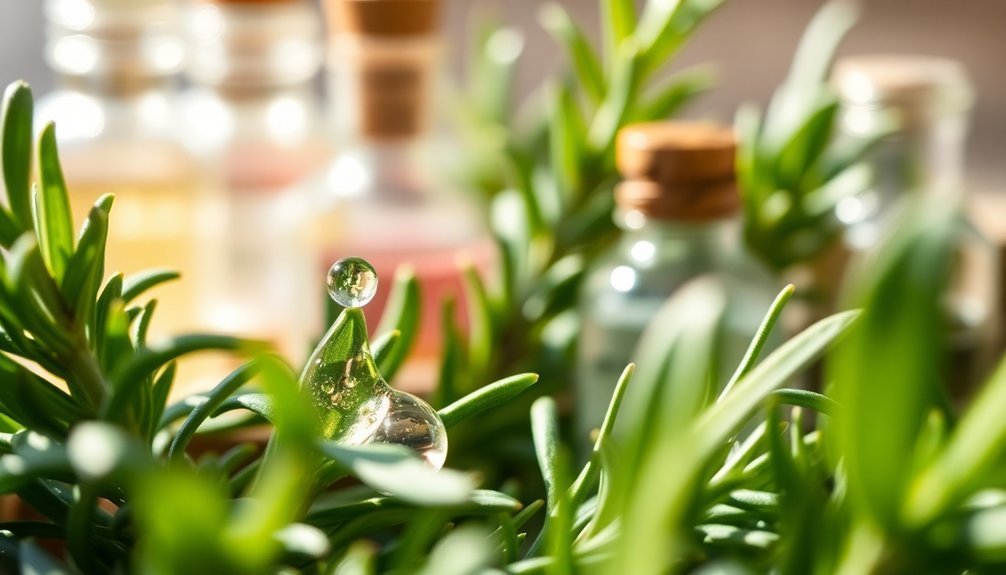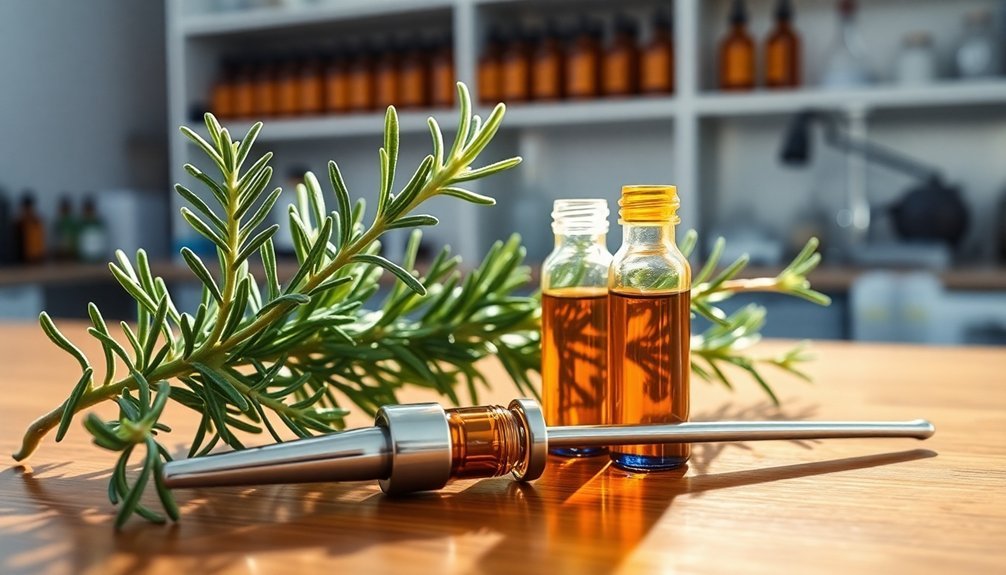Add rosemary extract at 0.2-0.4% concentration to your natural perfumes for powerful preservation. You'll want to store your blends in airtight glass containers away from light and heat, while keeping the pH below 8.5 for ideal effectiveness. Combine the extract with vitamin E and mixed tocopherols to enhance protection, and avoid metal containers during mixing. These key steps form the foundation of natural perfume preservation, but there's much more to master.
Understanding Rosemary Extract's Preservative Power

While many natural preservatives struggle to match the effectiveness of synthetic alternatives, rosemary extract stands out as a powerhouse of antimicrobial and antioxidant properties.
You'll find it's particularly effective against harmful microorganisms like listeria and salmonella, protecting your natural perfumes from microbial contamination.
What makes rosemary extract exceptional is its rich concentration of carnosic and rosmarinic acids, which prevent oxidation and rancidity. The extract's ability to maintain nutritional integrity ensures your natural perfumes retain their essential properties over time.
You can count on it to stabilize in most vegetable oils, even at low temperatures, making it ideal for oil-based perfumes.
It's proven more effective than mixed tocopherols in protecting natural oil blends, and you'll get even better results when you combine it with citrus extracts.
Best of all, it's FDA-approved and aligns with the growing consumer demand for clean-label ingredients.
Proper Storage Methods for Extended Shelf Life
Since proper storage directly impacts the longevity of your natural perfumes, understanding the right methods is essential for preserving rosemary extract's effectiveness.
Store your extract in clean, airtight glass containers, keeping them in a cool, dark place away from direct sunlight and heat sources. If you're blending with carrier oils, maintain low percentages (0.2-0.4%) and consider using an emulsifier to delay oxidation. The very viscous liquid nature of rosemary extract requires thorough mixing when incorporating into formulations.
You'll want to monitor your stored products regularly for any signs of spoilage. Label your containers with preparation dates and contents to track shelf life.
While rosemary extract remains stable at temperatures above 200°C, it's best to store it at standard room temperature. For maximum preservation, use vacuum-sealable bags to remove air and prevent moisture from compromising the extract's quality.
Ideal Ratios and Mixing Guidelines

Three key factors determine successful rosemary extract blending: concentration, carrier oil selection, and mixing technique.
Since essential oils have varying aroma strengths, careful ratio adjustment during blending is crucial for a balanced final product. You'll want to maintain a concentration between 0.2-0.4% of your total formula to preserve effectiveness while keeping the rosemary aroma subtle. Choose compatible carrier oils like sunflower, jojoba, or coconut to guarantee proper integration.
For ideal preservation results:
- Mix thoroughly into your chosen carrier oil, avoiding contact with metals like iron or copper.
- Keep the pH below 8.5 to maintain effectiveness.
- Test stability and microbial growth if you're using it as the sole preservative.
Maximizing Longevity With Complementary Ingredients
Proper ingredient combinations can dramatically boost the preservative power of rosemary extract in natural perfumes.
You'll get the best results by combining it with vitamin E and mixed tocopherols, as these create a synergistic effect that enhances oxidation protection.
When you're working with carrier oils like sunflower or soybean, add just 0.2-0.4% rosemary extract to prevent rancidity.
For essential oils, particularly citrus and conifer varieties, the extract helps maintain their chemical composition and aromatic profiles.
You can also pair it with an emulsifier to protect water-soluble compounds.
The extract's stability at temperatures above 200°C makes it versatile for various formulations.
Safety Measures and Quality Testing

When working with rosemary extract in natural perfumes, you'll need to implement strict safety protocols and quality control measures.
Always avoid contact with metals like iron and copper, especially at high temperatures, and guarantee your product's pH stays below 8.5 to maintain effectiveness.
While rosemary extract is stable at temperatures above 200°C, you'll want to monitor conditions carefully to prevent degradation.
- Conduct stability testing to verify the extract's effectiveness over time, particularly checking bioactive content levels of carnosic acid (7-7.5%).
- Perform solubility testing to confirm 100% dissolution in your chosen vegetable oils.
- Test the olfactory impact to guarantee the rosemary aroma doesn't overpower your perfume's intended scent at your chosen concentration (0.02-0.4%).
To maintain compliance, keep detailed documentation of all testing procedures and results.
Frequently Asked Questions
Can Rosemary Extract Be Used in Solid Perfumes and Wax-Based Formulations?
Yes, you can use rosemary extract in solid perfumes and wax-based formulations. It'll protect your products with its antimicrobial and antioxidant properties while blending well with other ingredients and extending shelf life.
Does Rosemary Extract Affect the Color of Clear or Light-Colored Perfumes?
Yes, rosemary extract can affect your perfume's color. You'll notice it adds a slight yellow tint to clear formulations, but if you're using it in low concentrations, the color change is usually minimal.
How Can I Tell if Rosemary Extract Has Lost Its Preservative Properties?
You'll notice your rosemary extract has lost its preservative properties if it shows dark discoloration, emits unusual odors, changes in viscosity, or if your product develops off-scents. Regular testing can confirm its effectiveness.
Can I Blend Different Types of Rosemary Extracts Together?
Yes, you can blend different rosemary extracts together. Try combining rosemary essential oil with CO2 extract or oleoresin to create a more complex aroma profile, but be mindful of their different concentrations.
Will Rosemary Extract Interfere With Synthetic Fragrance Ingredients?
You won't experience significant interference when using rosemary extract with synthetic fragrances. The extract's mild nature and reduced volatile components make it highly compatible, while its antioxidants can actually help stabilize your fragrance blend.
In Summary
You've now learned the essential steps for using rosemary extract as a natural preservative in your perfumes. Remember to store your creations in dark glass bottles, maintain proper ratios, and always perform patch tests. While rosemary extract won't preserve your perfumes indefinitely, following these guidelines will help extend their shelf life considerably. Keep monitoring your fragrances and trust your senses to guarantee they remain fresh and safe to use.





Leave a Reply